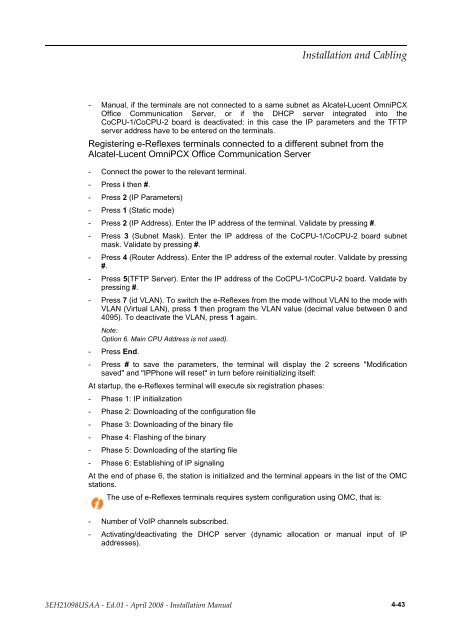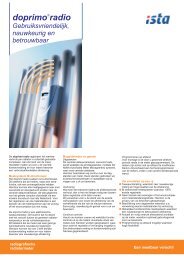Installation Manual
Installation Manual
Installation Manual
You also want an ePaper? Increase the reach of your titles
YUMPU automatically turns print PDFs into web optimized ePapers that Google loves.
- <strong>Manual</strong>, if the terminals are not connected to a same subnet as Alcatel-Lucent OmniPCX<br />
Office Communication Server, or if the DHCP server integrated into the<br />
CoCPU-1/CoCPU-2 board is deactivated: in this case the IP parameters and the TFTP<br />
server address have to be entered on the terminals.<br />
Registering e-Reflexes terminals connected to a different subnet from the<br />
Alcatel-Lucent OmniPCX Office Communication Server<br />
- Connect the power to the relevant terminal.<br />
- Press i then #.<br />
- Press 2 (IP Parameters)<br />
- Press 1 (Static mode)<br />
- Press 2 (IP Address). Enter the IP address of the terminal. Validate by pressing #.<br />
- Press 3 (Subnet Mask). Enter the IP address of the CoCPU-1/CoCPU-2 board subnet<br />
mask. Validate by pressing #.<br />
- Press 4 (Router Address). Enter the IP address of the external router. Validate by pressing<br />
#.<br />
- Press 5(TFTP Server). Enter the IP address of the CoCPU-1/CoCPU-2 board. Validate by<br />
pressing #.<br />
- Press 7 (id VLAN). To switch the e-Reflexes from the mode without VLAN to the mode with<br />
VLAN (Virtual LAN), press 1 then program the VLAN value (decimal value between 0 and<br />
4095). To deactivate the VLAN, press 1 again.<br />
Note:<br />
Option 6. Main CPU Address is not used).<br />
- Press End.<br />
- Press # to save the parameters, the terminal will display the 2 screens "Modification<br />
saved" and "IPPhone will reset" in turn before reinitializing itself:<br />
At startup, the e-Reflexes terminal will execute six registration phases:<br />
- Phase 1: IP initialization<br />
- Phase 2: Downloading of the configuration file<br />
- Phase 3: Downloading of the binary file<br />
- Phase 4: Flashing of the binary<br />
- Phase 5: Downloading of the starting file<br />
- Phase 6: Establishing of IP signaling<br />
At the end of phase 6, the station is initialized and the terminal appears in the list of the OMC<br />
stations.<br />
The use of e-Reflexes terminals requires system configuration using OMC, that is:<br />
- Number of VoIP channels subscribed.<br />
������������ ��� �������<br />
- Activating/deactivating the DHCP server (dynamic allocation or manual input of IP<br />
addresses).<br />
������������ � ����� � ����� ���� � ������������ ������ 4-43





